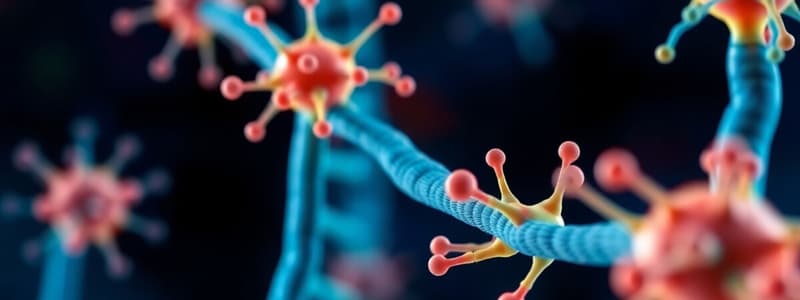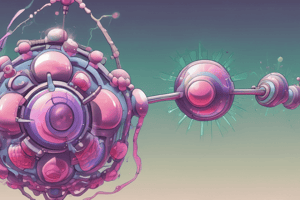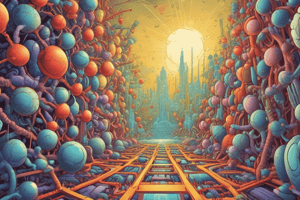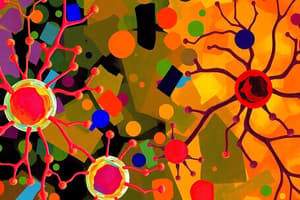Podcast
Questions and Answers
What characterizes nuclear receptors compared to cell surface receptors?
What characterizes nuclear receptors compared to cell surface receptors?
- Nuclear receptors bind hydrophilic signal molecules.
- Nuclear receptors activate transcription directly without forming complexes.
- Nuclear receptors can bind hydrophobic signal molecules. (correct)
- Nuclear receptors are located only in the plasma membrane.
What happens to homodimeric nuclear receptors when they bind to their ligand?
What happens to homodimeric nuclear receptors when they bind to their ligand?
- They remain in the cytosol permanently.
- They suppress transcription by recruiting repressors.
- They inhibit DNA binding sites in the cytosol.
- They translocate to the nucleus and activate transcription. (correct)
What is the role of heterodimeric nuclear receptors in the absence of their ligands?
What is the role of heterodimeric nuclear receptors in the absence of their ligands?
- They are located in the cytosol and engage in signal transduction.
- They convert histone acetylation to DNA methylation.
- They promote transcription by activating histone acetylation.
- They bind to their DNA targets and suppress transcription. (correct)
Which structural feature is common among nuclear receptors?
Which structural feature is common among nuclear receptors?
What is the function of the ligand-receptor complex once it enters the nucleus?
What is the function of the ligand-receptor complex once it enters the nucleus?
Which RNA polymerase is responsible for transcribing protein-coding genes in eukaryotes?
Which RNA polymerase is responsible for transcribing protein-coding genes in eukaryotes?
What role do transcription factors play in gene expression regulation?
What role do transcription factors play in gene expression regulation?
What is a distal enhancer?
What is a distal enhancer?
Which of the following RNA polymerases is involved in the transcription of tRNA?
Which of the following RNA polymerases is involved in the transcription of tRNA?
Which regulatory sequence is critical for the initiation of transcription in eukaryotes?
Which regulatory sequence is critical for the initiation of transcription in eukaryotes?
In eukaryotes, what are control elements found near the promoter called?
In eukaryotes, what are control elements found near the promoter called?
Which type of RNA polymerase is located in the nucleolus and is responsible for transcribing pre-rRNA?
Which type of RNA polymerase is located in the nucleolus and is responsible for transcribing pre-rRNA?
Which characteristic is true of prokaryotic RNA polymerases compared to eukaryotic RNA polymerases?
Which characteristic is true of prokaryotic RNA polymerases compared to eukaryotic RNA polymerases?
What is the effect of condensed chromatin on gene expression?
What is the effect of condensed chromatin on gene expression?
Which proteins are responsible for promoting chromatin decondensation?
Which proteins are responsible for promoting chromatin decondensation?
How do repressor proteins affect transcription?
How do repressor proteins affect transcription?
Why do all cells in an organism not express the same genes?
Why do all cells in an organism not express the same genes?
What mechanism primarily determines the levels of gene expression?
What mechanism primarily determines the levels of gene expression?
How do prokaryotes primarily control gene expression?
How do prokaryotes primarily control gene expression?
What term describes the binding of proteins to regulatory DNA sequences in transcriptional control?
What term describes the binding of proteins to regulatory DNA sequences in transcriptional control?
What is the role of transcription factors in gene expression?
What is the role of transcription factors in gene expression?
What is primarily indicated by the presence of a TATA box in a gene?
What is primarily indicated by the presence of a TATA box in a gene?
Which statement best describes eukaryotic promoter-proximal elements?
Which statement best describes eukaryotic promoter-proximal elements?
What is the role of acetylation in chromatin structure?
What is the role of acetylation in chromatin structure?
What differentiates heterochromatin from euchromatin?
What differentiates heterochromatin from euchromatin?
What types of signals generally influence transcription factor activity?
What types of signals generally influence transcription factor activity?
Which statement accurately reflects the function of transcription activators?
Which statement accurately reflects the function of transcription activators?
What is a primary characteristic of distant enhancers in eukaryotic transcription regulation?
What is a primary characteristic of distant enhancers in eukaryotic transcription regulation?
How do transcription factors typically exert their effects on pre-initiation complexes?
How do transcription factors typically exert their effects on pre-initiation complexes?
Flashcards
Eukaryotic Gene Regulation
Eukaryotic Gene Regulation
Controlling when and how much a gene is expressed in eukaryotic cells.
Chromatin Condensation
Chromatin Condensation
Tightly packed DNA, hindering gene expression.
Transcription Factors
Transcription Factors
Proteins that bind to specific DNA sequences, promoting or preventing gene expression.
Activator proteins
Activator proteins
Signup and view all the flashcards
Repressor proteins
Repressor proteins
Signup and view all the flashcards
Control Elements (Regulatory DNA sequences)
Control Elements (Regulatory DNA sequences)
Signup and view all the flashcards
Gene Expression Levels
Gene Expression Levels
Signup and view all the flashcards
Prokaryotic Transcription
Prokaryotic Transcription
Signup and view all the flashcards
Eukaryotic RNA Polymerases
Eukaryotic RNA Polymerases
Signup and view all the flashcards
RNA Polymerase I
RNA Polymerase I
Signup and view all the flashcards
RNA Polymerase II
RNA Polymerase II
Signup and view all the flashcards
RNA Polymerase III
RNA Polymerase III
Signup and view all the flashcards
Transcriptional control regions
Transcriptional control regions
Signup and view all the flashcards
Promoters
Promoters
Signup and view all the flashcards
Basal transcription factors
Basal transcription factors
Signup and view all the flashcards
TATA Box
TATA Box
Signup and view all the flashcards
Initiator
Initiator
Signup and view all the flashcards
CpG Island
CpG Island
Signup and view all the flashcards
Promoter-Proximal Elements
Promoter-Proximal Elements
Signup and view all the flashcards
Distant Enhancers
Distant Enhancers
Signup and view all the flashcards
Histone Acetylation
Histone Acetylation
Signup and view all the flashcards
Heterochromatin
Heterochromatin
Signup and view all the flashcards
Euchromatin
Euchromatin
Signup and view all the flashcards
Cell Surface Receptors
Cell Surface Receptors
Signup and view all the flashcards
Nuclear Receptors
Nuclear Receptors
Signup and view all the flashcards
Ligand-Receptor Complex
Ligand-Receptor Complex
Signup and view all the flashcards
Homodimeric Nuclear Receptors
Homodimeric Nuclear Receptors
Signup and view all the flashcards
Heterodimeric Nuclear Receptors
Heterodimeric Nuclear Receptors
Signup and view all the flashcards
Study Notes
Transcriptional Control of Gene Expression
- Eukaryotic genes are initially inactive, assembled into condensed chromatin, hindering RNA polymerase and transcription factor binding.
- Transcription control primarily revolves around the initiation and elongation phases. These phases crucially determine gene expression levels.
Overview: Eukaryotic Transcription Control
- Protein binding to regulatory DNA sequences influences gene transcription, either increasing or decreasing it.
- "Off" genes have condensed chromatin; "on" genes have decondensed chromatin.
- Activators bind to control elements (near or far from the initiation site) encouraging chromatin decondensation.
- Repressors bind to control elements promoting chromatin condensation.
Control of Transcription
- All cells within an organism have the same genome, but not all genes are expressed uniformly.
- Gene expression rates differ among cells, and can vary even within the same cell at different times.
- Measurements of RNA in various tissues show that a specific gene is expressed only in the cell types where it is actively used.
General Structure of an Operon
- Operons comprise the promoter (P) and operator (O) sites, along with structural genes.
- The operon's expression is regulated by the output of the regulatory gene (I).
Eukaryotic RNA Polymerases
- RNA polymerase is responsible for RNA synthesis during transcription.
- Eukaryotes have 3 types of RNA polymerase:
- RNA polymerase I is located in the nucleolus, transcribing genes for ribosomal RNA (rRNA) precursors.
- RNA polymerase II is involved in transcribing protein-coding genes into messenger RNA (mRNA), plus other types of small RNA, including microRNAs and small nuclear RNAs.
- RNA polymerase III transcribes genes for transfer RNA (tRNA), 5S rRNA, and other small stable RNAs.
Comparing Subunits of E. coli and Yeast RNA Polymerase
- Prokaryotes possess a single RNA polymerase.
- Eukaryotic and prokaryotic RNA Polymerases show significant similarities in core subunit structure.
- This similarity suggests a shared evolutionary origin of these enzymes.
Transcriptional Control Regions
- Protein-coding gene expression is regulated by multiple protein-binding DNA sequences.
- These sequences are generically known as transcriptional control regions.
- These include:
- Promoters: specify the RNA polymerase binding site.
- Promotor-proximal elements: Regulatory elements close to the promoter.
- Distal enhancers: Regulatory elements located further from the promoter.
Basal (General) Transcription Factors
- General transcription factors position RNA polymerase II at the start site.
- Assist in initiating RNA synthesis.
Promoters
- DNA sequences defining RNA polymerase binding sites and influencing transcription rates.
- Eukaryotic promoters include TATA boxes, Initiator elements, , and CpG islands.
TS Control Regions
-
Promoter-Proximal Elements regulate expression of eukaryotic genes in various types of cells.
-
These control regions are found from 100-200 bp upstream of the start site of transcription.
-
Distant Enhancers regulate the expression of eukaryotic genes in various types of cells.
-
These elements are found further from the start site of transcription.
Activators & Repressors of TS
- Transcription factors control the rate of transcription from a given promoter by acting as activators or repressors.
- Transcription factors often have two domains: DNA-binding and activation/repression domain.
- Activators and repressors affect histone acetylation/deacetylation which influences DNA condensation.
DNA-Binding Domains
- DNA-binding domains of transcription factors often contain common motifs.
- A common motif is the C₂H₂ zinc finger, others include homeodomain, basic helix-loop-helix, and the leucine zipper.
- The specified motifs involve a-helices that interact with the DNA major grooves.
Enhancers and Silencers
- Clusters of transcription factor binding sites are called enhancers or silencers.
- Enhancers are for activators, silencers are for repressors.
Enhancesomes
- Multiple transcriptional activators cooperate at enhancer sites to form an enhancesome.
- This large complex of transcription factors can bend DNA and facilitate RNA polymerase II binding, initiating transcription.
Assembly of RNApol II Pre-initiation Complex
- General transcription factors assemble near the start of a gene to position RNA polymerase II.
- Order of assembly is crucial.
Key Points about Chromatin Structure
- DNA in eukaryotic cells is highly organized, forming a complex called chromatin.
- DNA wraps around histone proteins forming nucleosomes.
- Histone tails (N-terminus of Histones) are flexible and modify chromatin structure via modifications like acetylation, phosphorylation etc.
Human Histones are Modified
- Histones are subject to various modifications including acetylation, methylation, and phosphorylation.
- These modifications influence chromatin structure.
Heterochromatin vs. Euchromatin
- Heterochromatin is condensed inactive chromatin, different in composition from active euchromatin.
- Euchromatin is active and open.
Comparison of 2 types of Chromatin
- Chromatin in inactive regions is tightly condensed (Heterochromatin), while active regions are relaxed (Euchromatin).
- Characteristics like sensitivity to DNase treatment, ionic strength, cell locations, and histone modifications distinguish them.
Mechanisms of TS Activation & Repression
- Transcriptional activators and repressors influence the pre-initiation complex either by modulating chromatin structure or through interaction with RNA polymerase II and general transcription factors.
- Several transcription factors can work together utilizing a common mediator complex to integrate their signals thus increasing the power of response.
Regulation of Transcription-Factor Activity
- Chemical signals that bind to cellular receptors can regulate transcription factor activity.
- Cellular receptors include cell-surface receptors for hydrophilic signals and nuclear receptors for hydrophobic signals.
Nuclear & Cell Surface Receptors
- Cell-surface receptors and nuclear receptors initiate responses to chemical signals.
- Signals bind to receptors and cause a cascade of cellular events that eventually reach the nucleus and lead to changes in transcription.
Examples of Hormones that Bind to Nuclear Receptors
- Lipid-soluble hormones diffuse through cell membranes and bind to nuclear receptors.
- This triggers a cascade of events leading to transcription activation.
Nuclear Receptor Superfamily TS Factors
- The N-terminus has an activation domain, the DNA-binding domain contains repeated zinc finger motifs, and the C-terminus has a ligand-binding domain for response to signal molecules.
Homodimeric Nuclear Receptors
- Some nuclear receptors exist as dimers functioning in the binding of ligand.
- The hormone binding allows the receptor complex to translocate to the nucleus initiating transcription.
Heterodimeric Nuclear Receptors
- Nuclear receptor complexes can involve different receptors as dimeric complexes.
- In the absence of ligand, these homo or hetero dimers repress transcription, but their binding to ligand stimulates transcription.
Studying That Suits You
Use AI to generate personalized quizzes and flashcards to suit your learning preferences.




